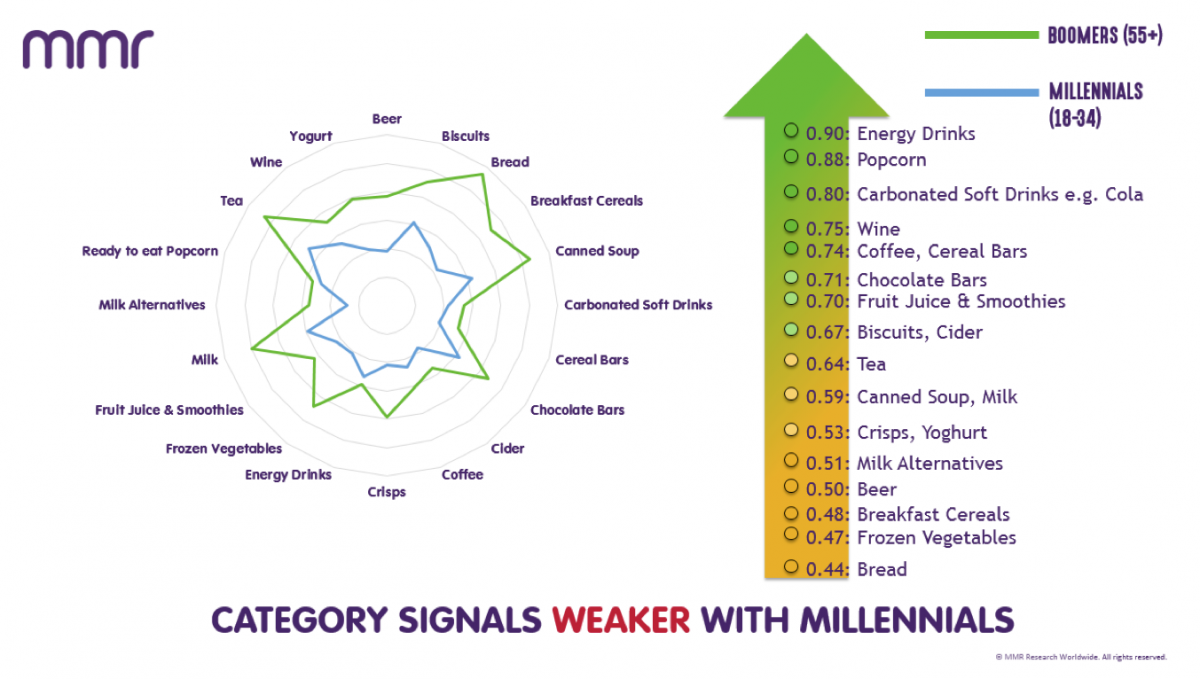By Andrew Wardlaw
In the second of three sensory themed articles, we make the case for a sensory led approach to brand, pack and product development. With Millennials making faster, intuitive, emotion based decisions, communications need to work at the non-conscious level. A true sensory approach can achieve this.
What is Sensory?
Many companies think they do sensory. But there is a huge difference between collecting sensory liking data (think ‘Just About Right’ scores) and a true sensory led approach. The latter has the power to translate brand equities into physical markers across pack and product. Done right, these can reinforce (even amplify) your distinct positioning & advantage. The aim of a sensory led approach is a seamless consumer experience across all touchpoints – where the whole is greater than the sum of its parts.
The Millennial Issue
In late 2016, MMR commissioned a study featuring over 3,500 U.K participants of all ages, with robust numbers of Millennials (typically 18-34), Generation X (35-54) and Baby Boomers (55+).
The aim of the study was simple. We wanted to understand if Millennials were so different to their elders in respect of health, diet & lifestyle. The suggestion was that if women are from Venus, and men are from Mars – Millennials are from another universe entirely. Second, given that many brand owners ask us where all the Millennials have gone in their panel data, we wanted to capture levels of emotional engagement across 20 leading FMCG categories.
The results made startling reading. Anyone who suggests that Millennials lack the attention spans of their elders is (I’m afraid to say) not far from the mark. And this means brand owners will need to communicate in new ways.
Whilst the study underlines that Millennials are not dramatically different in the way they divide to previous generations – though they are more image concerned – they exhibit much lower levels of emotional engagement in almost all FMCG categories – from Breakfast Cereals to Yogurt.
The study had asked all participants to rate the strength of association between 25 functional & emotional terms (for example, ‘Genuine’, ‘Trustworthy’, ‘Masculine’, ‘Comforting’ & ‘Sophisticated’) and the categories they were most familiar with.
The results showed that whilst the ranked order of associations (strongest to weakest) is largely mirrored between generations, the level of conviction – that is to say, the strength of the association, was much weaker. In some cases, Millennial conviction rates were about half those of their elders.
The chart below plots the ‘category signal’ for Millennials and their Baby Boomer elders. As you can see, the signal is markedly weaker with Millennials, with this pattern would most likely be replicated at a brand level.

Our interpretation of this? Whilst we accept that Millennials are younger and have had less time to form opinions, there is a lot of evidence to suggest that our minds are largely made up by our mid-twenties. Looking at our data, participants 25-34 exhibited similar levels of conviction to those 18-24.
Our strong hypothesis is that as digital natives, Millennials have developed advanced coping mechanisms for the vast increase of information at their fingertips. Fast filtering (including the skipping of advertising) just about covers it! It’s highly likely this behaviour is reflected in how they interact with the modern world at large – and there are huge implications for brands. Most notably, how do you get your brand equities across to this audience in a way that they will register?
The answer is to communicate in a way that the emerging consumer isn’t aware that communication has actually taken place!
Non-conscious Communication
By embracing a sensory led approach to pack and product design, you’re taking a step towards better non-conscious communication.
So imagine you’re a popular healing skincare brand. Your brand commands a range of functional & emotional equities such as ‘powerful’, ‘effective’ and ‘reassuring’. In the past, you’ve spent millions reinforcing these on TV and the written word. Except, the Millennial isn’t tuning into ads. They never grew up absorbing the kind of messaging that their parents did.
For the brand manager taking the plunge into a sensory led approach, they would seek to understand how their pack and the product could reinforce these valued equities more forcefully at a physical level. What pack structures, substrates and colourways could better amplify ‘powerful’? What colour, texture (viscosity) and aroma etc. of the product could better amplify ‘effective’? And so forth.
If you know that Millennials exhibit the need states of powerful, effective and reassuring when selecting a product in store, then you need to get to a point where your offer communicates these properties via the brand’s sensory assets – so the shopper can zone in on them at an intuitive level. In effect, you want to create a ‘mindless’ purchasing situation.
All to Play For
Our deep dive into the perceptions of Millennials has revealed an urgent need for brand owners to increase levels of non-conscious communication to connect with the emerging shopper. Fact is, Millennials are never going to reach the same level of understanding of FMCG categories and brands as their parents, so how we communicate with our audiences MUST change.
So rather than channelling funds into even more social media, (even more noise for Millennials to filter), isn’t it about time your brand considers a sensory led approach to how you configure you brand, pack and product –and amplify your equity non-consciously?
You already have sensory assets. Make them work harder for you.
By Andrew Wardlaw, Director of Insight at MMR Research Worldwide


